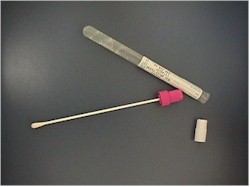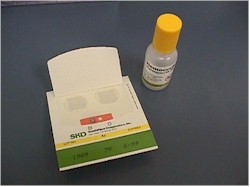
|
Lesson 2: Specimen Collections
One means of gathering information about the patient's health status is by identifying pathogens and analyzing urine, blood, sputum, and feces. As a practical nurse, you may be responsible for collecting and labeling specimen for analysis and ensuring their delivery to the lab. For self-protection and to prevent the spread of disease, wear gloves whenever you work with body fluids. Washing your hands carefully also prevents the spread of disease.
Throat cultures are done to isolate and identify any pathogens, which may be medium. The slide or medium is incubated in the laboratory to determine which organisms causing a throat disorder. A sample of mucus and secretions from the back of the throat is collected on a cotton-tipped applicator and applied to a slide or culture are present. A determination of which drug is most effective against a particular organism may be done also. A full culture and sensitivity test takes several days because the organisms must have time to grow. If strep infection is suspected a quick strep test may be done, so that antibiotic therapy can be started immediately.
The supplies and equipment required to obtain a sample for throat culture are:
a. Sterile cotton-tipped applicator specimen collection kit (culturette).
b. Tongue depressor.
d. Flashlight.
2-4. PROCEDURE FOR A THROAT CULTURE
Always wash your hands before the procedure. Explain to the patient what you are going to do. Have the patient sit comfortably on a bed or chair and tilt his head back.
a. Use the flashlight to illuminate the back of the throat. Check for inflamed areas using the tongue depressor.
b. Ask the patient to say "Ahhh" as you swab the tonsillar areas from side to side. Be sure to include any inflamed of purulent sites.
c. Avoid touching the tongue, cheeks, or teeth with the applicator, as this will contaminate it with oral bacteria.
d. Place the cotton-tipped applicator into the culture tube immediately.
e. Label the culture tube with the patient's name, SSN, and ward number if applicable.
f. Complete the request form (SF 553) with the following information:
(1) Patient's name.
(2) Patient's rank or status.
(3) Family member prefix and sponsor's social security number.
(4) Ward number if inpatient, or phone number if outpatient.
(5) Source of the specimen (that is, throat).
(6) Any antibiotics the patient is taking.
(7) Date and time the specimen was obtained.
(8) Name of the physician who ordered the culture.
For some respiratory disorders, a sputum specimen is obtained for culture or other examination to determine if any pathogens or blood are present. The specimen should be collected early in the morning before the patient eats, brushes his teeth, or uses mouthwash. The specimen is more likely to contain sputum at this time, rather than just saliva. Specimens are often taken for three consecutive days because it is difficult for the patient to cough up enough sputum at one time, and an organism may be missed if only one culture is done.
Supplies and equipment required to collect a sputum specimen are
a. Sterile container with tight-fitting lid.
b. Box of tissues.
c. Gloves.
d. Laboratory request form (SF 553).
|
2-7. PROCEDURE FOR SPUTUM SPECIMEN
a. Wash your hands and gather the equipment.
b. Provide privacy for the patient and explain the procedure. Place the tissues nearby and have the patient rinse his mouth with clear water to remove any food particles.
c. Assist the patient to a sitting position, if necessary and ask him to cough deeply and spit into the container. Tell the patient to avoid touching the inside of the container because it is sterile.
d. A sputum specimen is considered highly contaminated and must be treated with caution. To prevent contamination by particles in the air, keep the container closed until the patient is ready to spit into it. Close the container immediately after collecting the specimen to prevent the spread of any organisms from the specimen. Offer tissues for the patient to wipe his mouth.
e. Wash your hands, label the container, and complete the laboratory request form. Take the specimen to the laboratory immediately; allowing the specimen to remain in a warm place will result in overgrowth of any organisms that may be present.
f. Record the amount, consistency, and color of the sputum collected, as well as the time and date in the nursing notes.
Stool specimen are collected for many examinations. The most common is the ova and parasites test, a microscopic examination of feces for detecting parasites such as amebas or worms. Stools specimen are often tested for blood. Guaiac or HemOccult test may be done in the laboratory but are sometimes done at the nursing station to test a stool for occult blood.
Supplies and equipment required to collect a stool specimen are
a. Gloves
b. Clean bedpan and cover (an extra bedpan or urinal if the patient must void).
c. Specimen container and lid.
d. Wooden tongue blades.
e. Paper bag for used tongue blades.
e. Labels.
f. Plastic bag for transport of container with specimen to laboratory.
2-10. PROCEDURE FOR STOOL SPECIMEN
a. Explain the reason for the test and the procedure to the patient. Ask the patient to tell you when he feels the urge to have a bowel movement.
b. Wear gloves when handling any bodily discharge (see universal precautions in the introduction to this subcourse).
c. Give the bedpan when the patient is ready. If the patient wants to urinate first, give a male the urinal or give a female the extra bedpan.
d. Remove the bedpan. Use the tongue blade to transfer a portion of the feces to the specimen container. Do not touch the specimen because it is contaminated. It is not necessary to keep this specimen sterile however, because the gastrointestinal tract is not sterile.
e. Cover the container and label it with the patient's name and social security number.
f. Complete the appropriate laboratory request form, noting any special examination ordered.
g. Take the specimen to the lab immediately; examination for parasites, ova, and organisms must be made while the stool is warm.
h. If an infant's stool is to be examined, place the diaper in a leakproof bag, label it, and take the diaper and request form to the lab immediately.
The purpose of this test, using guaiac as a reagent, is to detect the presence of occult blood (blood that appears from a nonspecific source, with obscure signs and symptoms), which is not visible. Each method of testing has a specific procedure, which must be followed to get accurate results. If it is done at the nursing station, instructions should be kept with the reagents used. Follow the manufacturer's instructions or consult hospital standing operating procedures (SOP).
|
|||||||||
|
LESSON OBJECTIVES |
|||||||||
|

